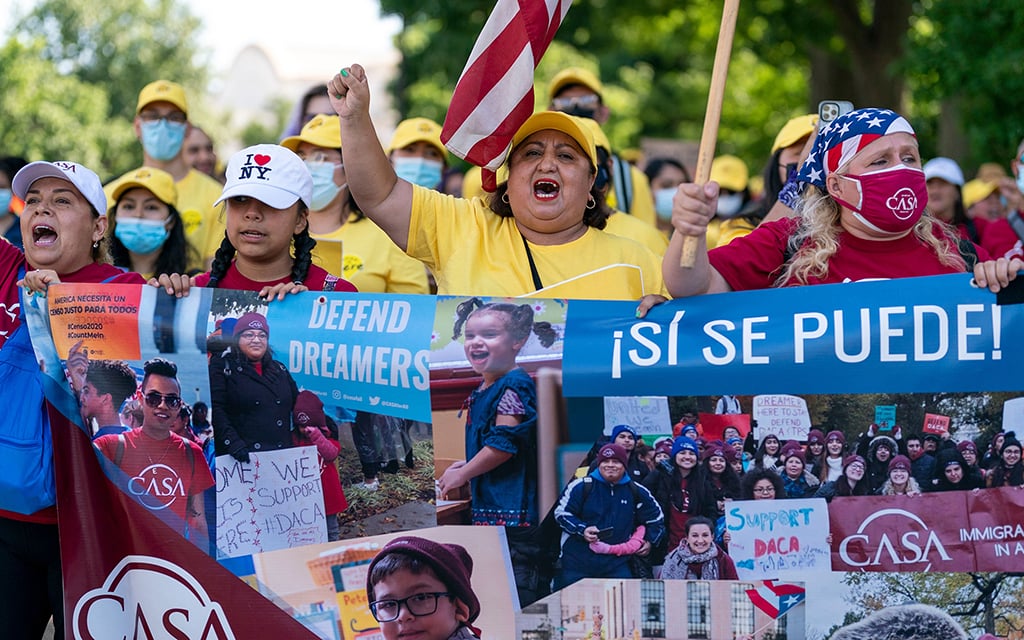
A Customs and Border Protection agent prepares migrants for a repatriation transfer at the Hidalgo. Texas, Port of Entry on June 1. After dropping in May and June, border encounters surged in July. (Photo by Jaime Rodriguez Sr./Customs and Border Protection)
WASHINGTON – Migrant encounters at the southwest border surged in July, reversing two months of declining numbers but still well below previous highs posted earlier in this fiscal year.
Encounters rose from 144,566 in June to 183,503 in July, with migrant families accounting for more than three-quarters of that increase, according to the latest data from Customs and Border Protection.
The Tucson sector also surged to the top of the list in July, with its 39,215 encounters almost 13,000 higher than the second-place Rio Grande Valley sector in Texas.
Experts were not surprised by the increase, saying it was to be expected after migrants took a “wait and see” attitude after the imposition of new regulations in May.
“This is, you know, primarily being driven by families from the Northern Triangle of Central America – El Salvador, Honduras and Guatemala,” said David Bier, associate director for immigration studies at the Cato Institute. “And those … families had been shut out under Title 42 until May.”
Title 42 was the public health rule enforced by the Trump administration during the COVID-19 pandemic that allowed border agents to turn back migrants at the border. President Joe Biden campaigned on a pledge to end the policy, but it took more than two years – until May 11 of this year – to stop its enforcement.
Despite fears that immigration would surge after the lifting of Title 42, numbers actually fell from 211,999 in April to 206,701 in May before plummeting to 144,566 in June.
Ariel Ruiz, the senior policy analyst at the Migration Policy Institute, said the July increases are not the result of “any one particular policy change,” but come from the U.S. continuing to enforce an outdated immigration policy that was “implemented to deter Mexican migration in the ’90s.”
One of the changes implemented by the Biden administration this year is the expansion of the parole program, which lets migrants from authorized countries be admitted to the U.S. for up to two years if they have a sponsor here and pass background checks. The plan, announced in January, allows a total of up to 30,000 admissions a month for migrants from Haiti, Cuba, Nicaragua and Venezuela.
Critics of the administration said the parole policy has typically only been used for isolated instances, not broad admissions policy.
Ira Mehlman, media director at the Federation for American Immigration Reform, which advocates for tough border restrictions, said the “president doesn’t have unlimited authority to parole people into the United States.”
“All the administration has been doing is playing a shell game,” Mehlman said. “They don’t want to stop mass illegal immigration, they just want to make it less visible.”
The administration also expanded the number of refugees who can be resettled in the U.S., and tightened border enforcement to encourage migrants to follow legal pathways here by showing up at ports of entry to request asylum.
In Tucson, where the number of migrants surged in July, an official who works with the individuals and families who come here in hopes of a better future, said the dangers they face en route “really speaks to the situation that they’ve been fleeing from, from for so long.”
Diego Piña Lopez, the agency director for the shelter Casa Alitas, has seen migrants from Central America who have made the dangerous journey crossing multiple countries to reach the United States.
“I’ve never seen an increase like this historically in the summer before. So it’s been unique challenge for us,” he said.
“This year, we’ve seen … the increase of people coming through. So that makes me concerned of their safety as they’re going through the desert and we do see people dehydrated and unsafe conditions because of that,” Piña Lopez said.
While volunteers at the shelter might not know those in their care, for Piña Lopez it’s more about being there for those making the desperate journey, some of whom have lost family members to get here.
“We are sometimes strangers to one another in this world nowadays,” he said. “But at least community kind of bridges…makes people less strange from one another.”

